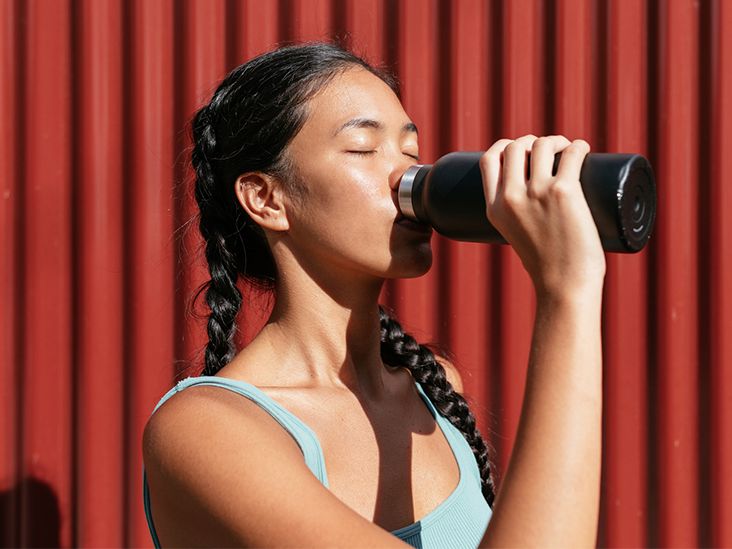A balanced diet and regular cardio exercise may help reduce body fat in your face and cheeks. Certain facial exercises can also help strengthen and tone the facial muscles.
If you wish to lose some body fat from your cheeks, neck, or chin, you’re not alone.
Many slimming straps and devices on the market claim to boost facial fat loss, but minimal research supports these claims.
Losing body fat typically requires making long-term changes to your diet and lifestyle.
Here are eight effective methods to help you lose unwanted face fat and make your face appear slimmer, along with some strategies to help prevent fat gain in the long term.
Can you lose fat from just your face?
Targeting a specific body part for fat loss is known as spot reduction.
Although there are many claims in the fitness industry about being able to target fat loss in the face specifically, there’s little evidence to support the concept of spot reduction.
This may be because fat cells are stored
Focusing on overall fat loss may be the most effective and sustainable approach to losing facial fat.
Facial exercises may help improve facial appearance, combat aging, and improve muscle strength.
A 2021 research review also found that facial exercises may help tone facial muscles, increase fullness in the cheeks, and improve facial rejuvenation. These effects may contribute to a slimmer facial appearance.
Despite these findings, there is limited research on the effectiveness of facial exercises for fat loss. More studies are needed to evaluate how these exercises may affect facial fat.
Some popular facial exercises may include:
- puffing out your cheeks and pushing the air from side to side
- puckering your lips on alternating sides
- holding a smile while clenching your teeth for several seconds at a time
Cardio, or aerobic exercise, is any type of physical activity that increases your heart rate.
A 2023 study in 60 women examined the effects of a 12-week aerobic exercise program on body composition.
After 12 weeks, the participants who engaged in the aerobic exercise program experienced significant reductions in body fat percentage, body weight, and waist circumference, while also gaining lean muscle mass.
The Centers for Disease Control and Prevention (CDC) recommends adults get
Some common examples of cardio exercise include:
- running
- dancing
- walking
- biking
- swimming
Drinking water is crucial for overall health and may play a role in losing facial fat.
A 2019 review found that the following three water-based interventions contributed to a
- drinking more water throughout the day
- replacing caloric drinks with water
- drinking water before a meal
The authors noted that replacing caloric drinks with water was the most effective weight loss remedy, but overall, more research is necessary on the efficacy of drinking more water for fat loss.
A small 2018 study found that drinking water before a meal decreased the number of calories consumed during the meal. Eating fewer calories during the day could help you maintain a calorie deficit, which is key for weight loss.
Enjoying the occasional alcoholic beverage is fine, but
Alcohol contains mostly “
It also acts as a diuretic — a substance that increases urine production — which may lead to dehydration and water retention.
Limiting your alcohol consumption may be the best way to avoid alcohol-induced bloating and weight gain. The
Foods containing refined carbs, such as cookies, crackers, and pasta, are common culprits of weight gain and increased fat storage.
Refined carbs are heavily processed, stripping them of their beneficial nutrients and leaving little behind besides sugar and calories.
No studies have examined the effects of refined carbs on facial fat, but 2021 research found that whole grains were less likely to increase waist circumference, body fat, and some metabolic markers over a 4-year period than refined carbs.
Replacing refined carbs with whole grains may help increase overall weight loss, which may also aid facial fat loss.
Consider swapping refined carbs for whole grains, such as oatmeal, brown rice, and quinoa.
Getting enough sleep may play an important role in your overall fat loss journey.
Experts suggest that sleep deprivation may contribute to increases in weight gain and fat storage in several ways, such as:
- affecting hormones involved in hunger management, such as cortisol, leptin, and ghrelin
- reducing feelings of fullness
- increasing your likelihood of snacking, which may lead to consuming extra calories
- reducing your metabolic rate and fat oxidation
Not getting enough sleep may also affect your ability to successfully maintain weight loss.
The CDC recommends adults get at least
Learn more about sleep for weight loss.
Table salt is the main source of sodium in most people’s diets. You might add it to food from a shaker, but over 75% of dietary sodium intake comes from processed foods.
A trademark symptom of consuming too much sodium is fluid retention (edema), which happens because sodium causes your body to hold on to extra water.
Edema usually causes puffiness in your ankles, arms, and legs but may also contribute to facial puffiness.
Consider replacing convenience foods, savory snacks, and processed meats with whole foods to help reduce your sodium intake and possibly make your face appear slimmer.
Learn more about how to reduce fluid retention.
A popular recommendation for overall weight management and possibly losing facial fat is increasing your fiber intake.
Fiber is a substance in plant foods that your body doesn’t absorb after you consume it. Instead, it moves slowly through your digestive tract, keeping you feeling fuller for longer. In this way, it may help curb cravings and decrease appetite.
A 2020 review of 62 studies found that eating more soluble fiber may help reduce body weight and waist circumference, even if you don’t restrict your calorie intake.
The Dietary Guidelines for Americans recommends consuming
Fiber is a natural component in a variety of foods, including:
- fruits
- vegetables
- nuts
- seeds
- whole grains
- legumes
Several strategies may help you reduce overall body fat, which can lead to reducing fat in your face.
Switching up your diet, adding exercise to your routine, and adjusting some of your daily habits are all effective ways to increase fat loss.
If you’re still concerned about facial fat, consider speaking with a healthcare professional. They may recommend other treatments.










